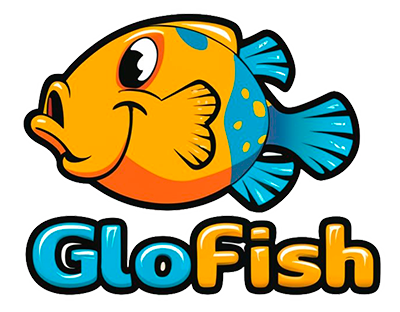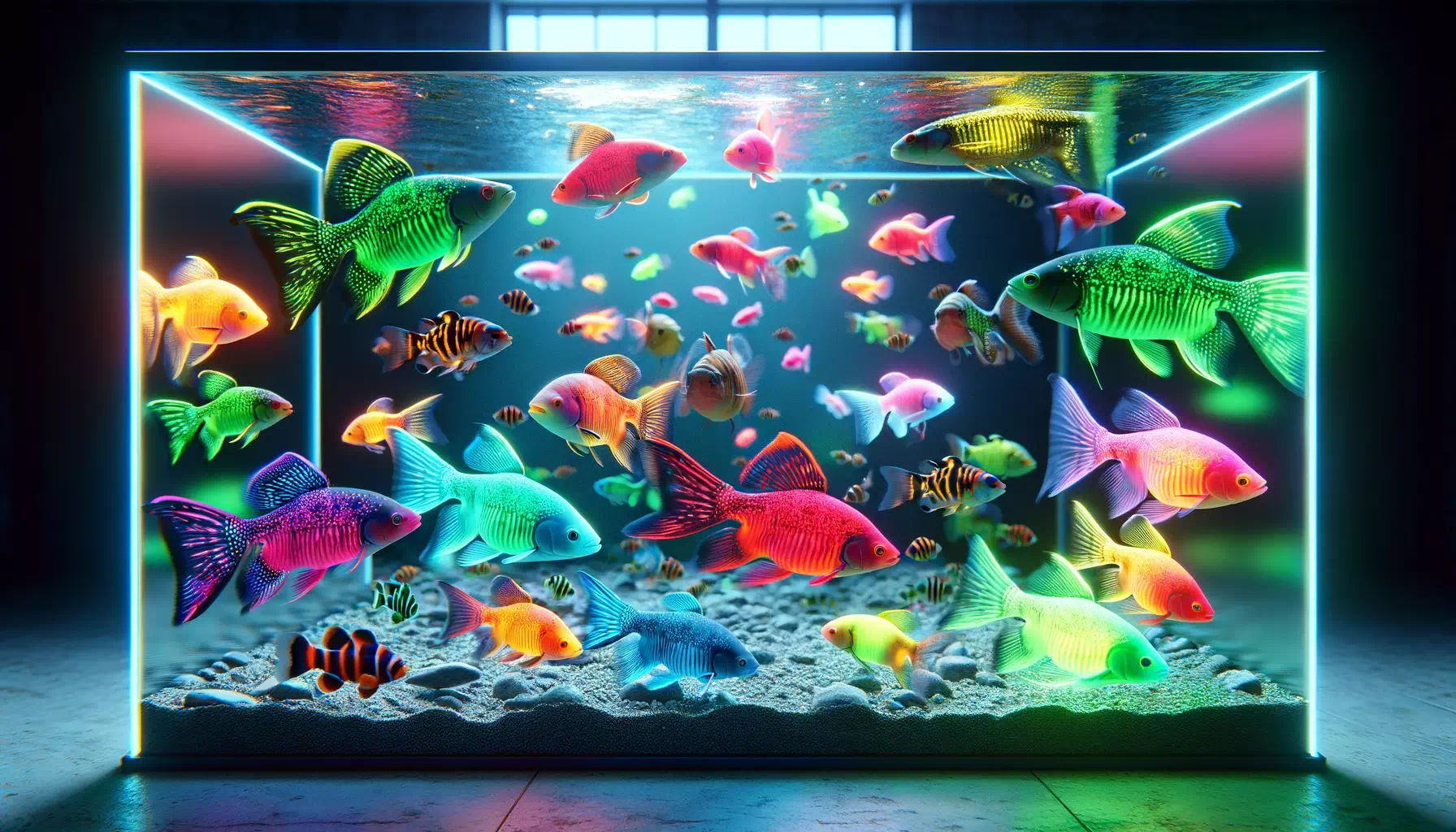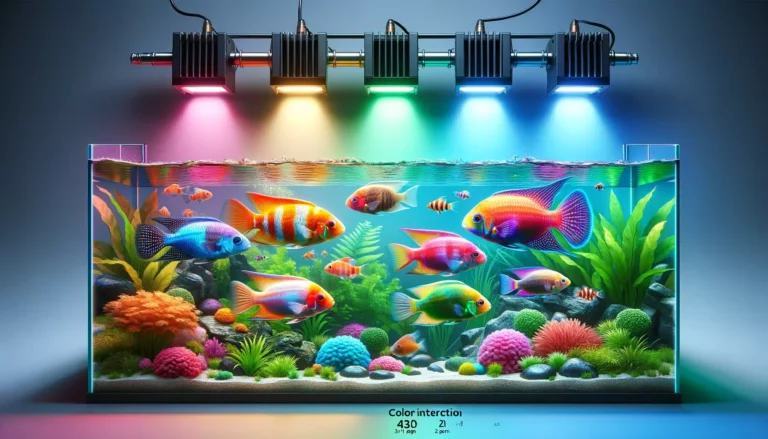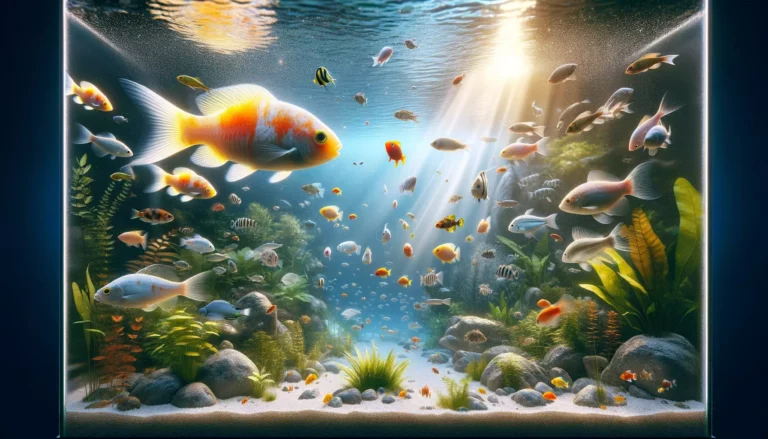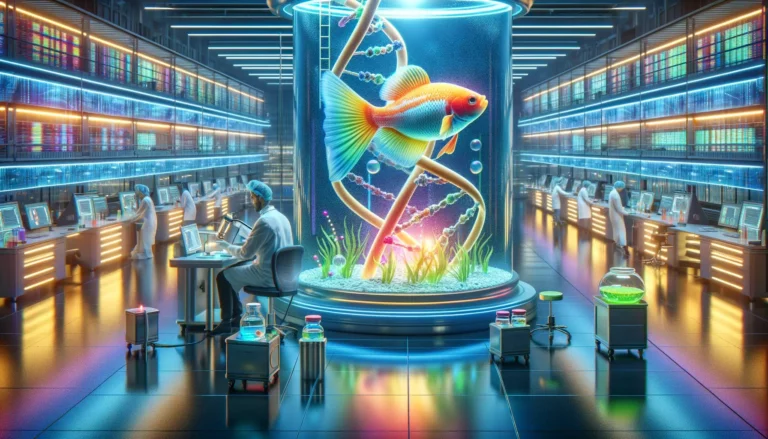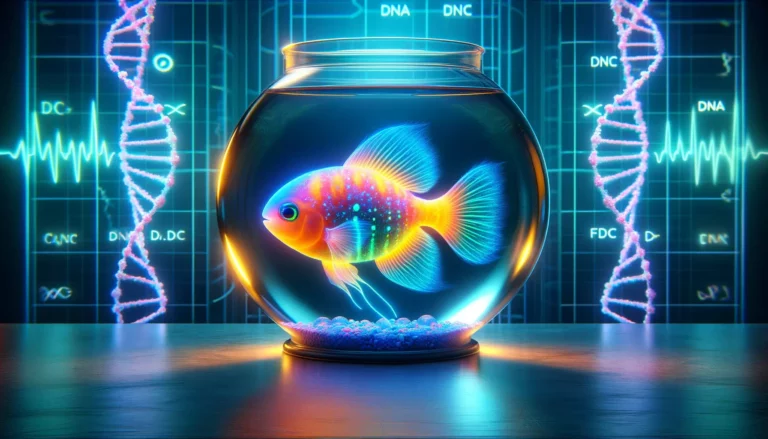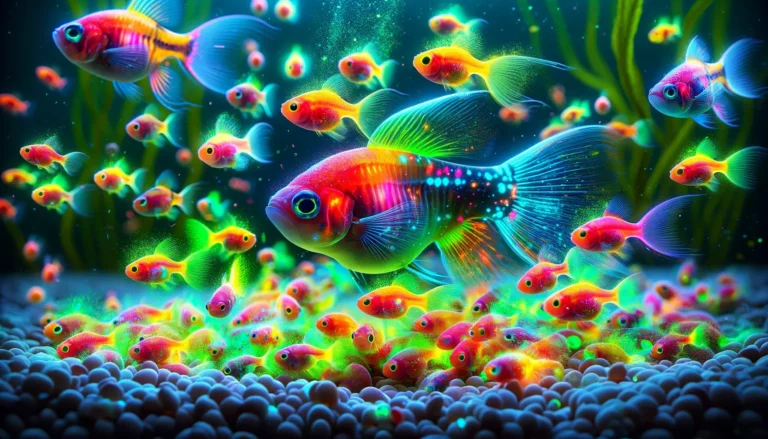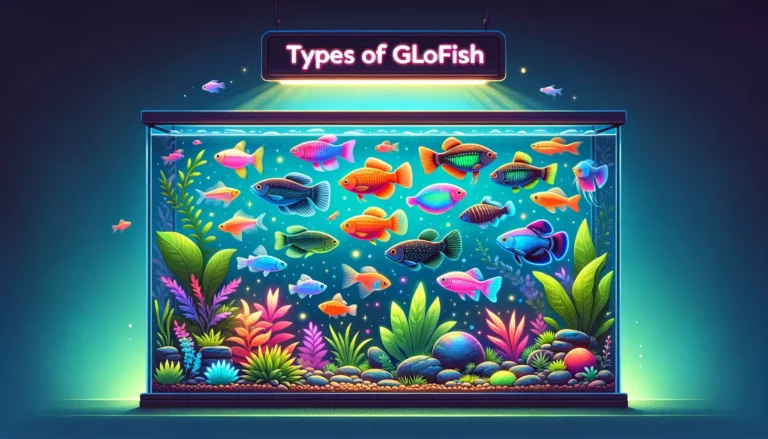What types of GloFish exist and what are their differences?
Welcome to the fascinating world of GloFish! These are not your ordinary aquarium fish. They have a unique appeal, thanks to their vibrant colors. GloFish are genetically modified to glow under certain lights. This feature makes them popular among aquarium enthusiasts. In this blog, we’ll dive deep into their world. We’ll explore the different types of GloFish and their distinctive characteristics. Get ready to learn about these dazzling inhabitants of the underwater world!
In this post, we aim to explore the diverse world of GloFish. These fish are special for their bright colors and glow. Our goal is to understand the different types of GloFish and their unique traits. We’ll look at how they differ from each other in appearance and behavior. This will be a guide for beginners who are curious about these colorful creatures. Whether you’re a seasoned aquarist or new to the hobby, you’ll find this exploration of GloFish informative and interesting. Let’s embark on this colorful journey together!
Original Types of GloFish
GloFish Zebra (GloFish Zebra Danio)
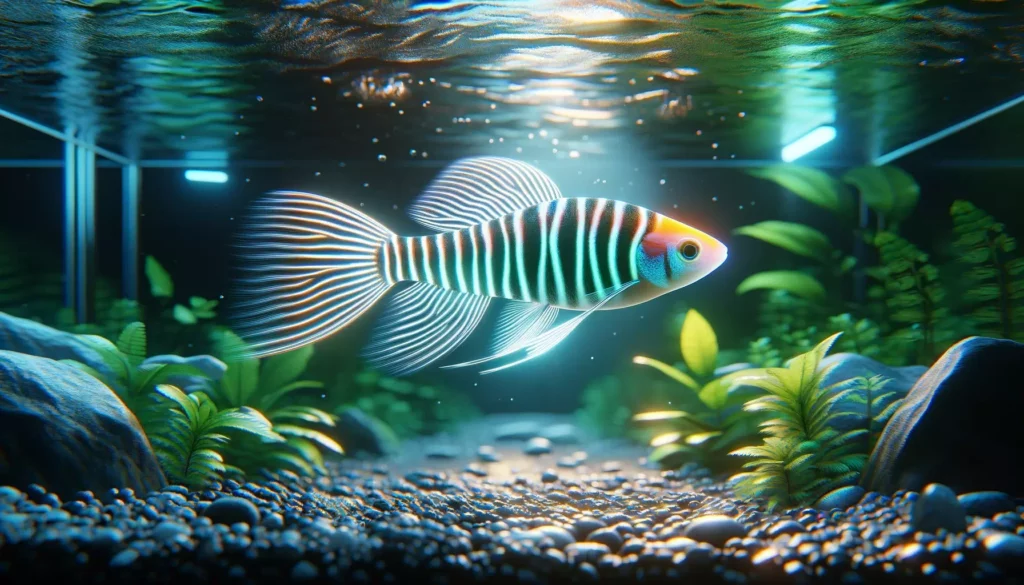
GloFish Zebra Danios stand out in the aquarium world. They are not just any fish; they are the pioneers of the GloFish family. Originating from the Zebra Danio, a freshwater fish known for its hardiness and adaptability, GloFish Zebra Danios bring a splash of color to any tank.
The GloFish Zebra Danio dazzles with a range of bright colors. You might find them in brilliant shades like red, green, blue, purple, and orange. Their glowing color is not just a coating or dye; it’s a result of genetic modification. The fish inherit this trait right from birth. These colors shine brightly under both white and blue lights, turning your aquarium into a living kaleidoscope.
These fish are not just about their colors. They maintain a convenient size for aquariums, typically reaching up to 2 inches in length. This size makes them a perfect fit for community tanks. They are active swimmers and prefer to be in groups. Watching a school of GloFish Zebra Danios can be a mesmerizing experience, as their colors create a dynamic display.
The creation of GloFish Zebra Danios has a story rooted in science. Initially, the fluorescent color was a byproduct of environmental research. Scientists were studying how to detect pollution in water bodies. They introduced a naturally occurring fluorescent gene into the fish. The goal was to create fish that would glow in the presence of pollutants. This groundbreaking research led to the first GloFish – the Zebra Danio. While their ability to detect pollution is not used in home aquariums, their stunning appearance has made them a favorite among fish enthusiasts.
The GloFish Zebra Danio is more than just a pet. It represents a blend of nature and science. Its creation marked the beginning of a new era in the aquarium hobby. These fish are not only a testament to scientific advancement but also a source of joy and color in aquariums around the world. Whether you’re a beginner or an experienced aquarist, GloFish Zebra Danios can add a unique flair to your aquatic collection.
GloFish Tetra
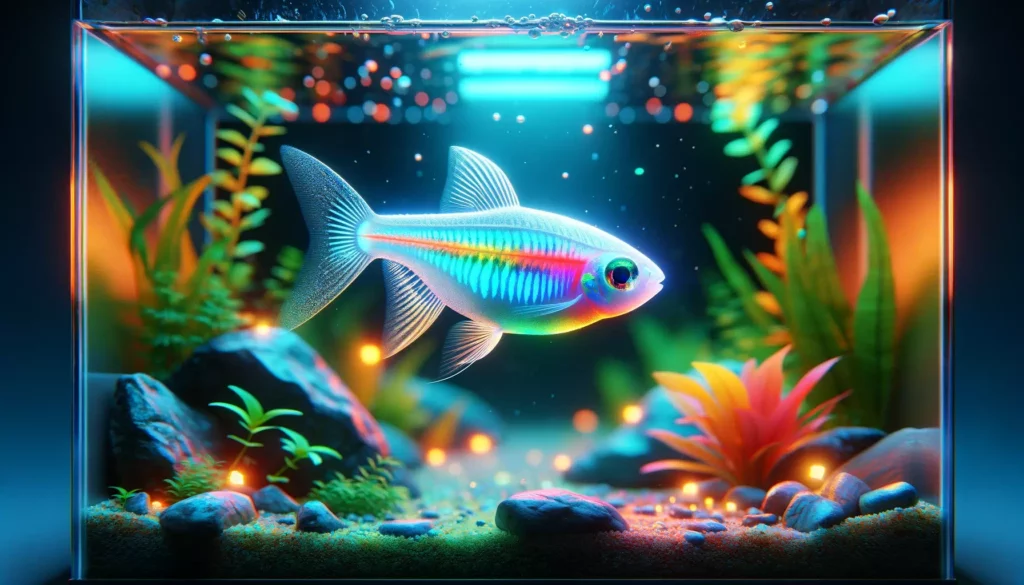
GloFish Tetras are another fascinating member of the GloFish family. These fish are known for their lively behavior and stunning luminescence. Originating from the Black Skirt Tetra, GloFish Tetras have been genetically enhanced to glow in a range of radiant colors.
What sets GloFish Tetras apart is their unique body shape and schooling behavior. They have a fuller body compared to the slender Zebra Danio, and they display a captivating dance-like movement when swimming in groups. These tetras are available in vibrant colors like pink, green, purple, and blue. Under the right lighting, their colors become even more intense, creating a dazzling effect in any aquarium.
GloFish Tetras typically grow to about 2.5 inches in length. Their size, along with their peaceful nature, makes them an excellent choice for community tanks. They are hardy fish, adaptable to various tank conditions, which is great for beginners.
The creation of GloFish Tetras involved the introduction of a fluorescent protein gene into the Black Skirt Tetra’s genome. This gene, originally found in marine organisms like jellyfish and coral, is responsible for their glowing appearance. The gene integration was meticulously done to ensure that the fish would inherit the fluorescent trait naturally. This genetic modification doesn’t just give them their unique color but is also stable across generations, meaning the vibrant glow is passed down to their offspring.
GloFish Tetras are more than just their glowing colors; they are a testament to the wonders of genetic research. While they were initially created to help in scientific studies, their beauty and unique characteristics have made them a favorite in the world of aquariums. They are not only a visual delight but also an intriguing example of how science can intersect with everyday life, bringing a piece of the ocean’s mystique into our homes. Whether in a school or as individuals, GloFish Tetras add a dynamic and colorful presence to any aquarium.
Modern Types of GloFish
GloFish Barb
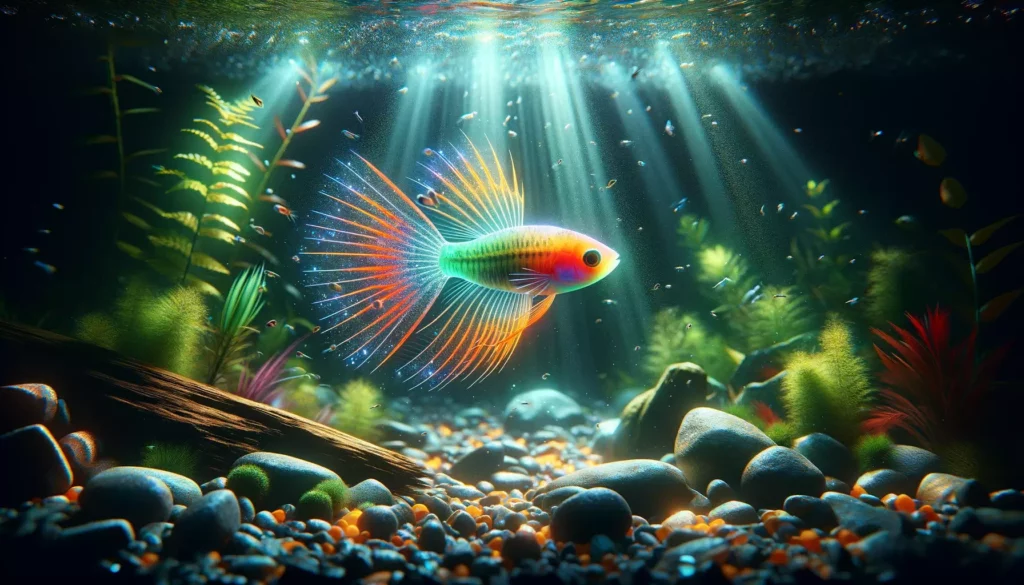
GloFish Barbs represent the evolution of the GloFish family, showcasing the advancements in genetic modification and aquarium aesthetics. These are a newer addition, bringing a fresh vibe to the GloFish spectrum. Originating from the Tiger Barb, known for its bold stripes and dynamic swimming, GloFish Barbs have been transformed into glowing beauties, offering a blend of traditional Barb characteristics and futuristic luminescence.
GloFish Barbs stand out for their striking patterns and active behavior. They are slightly larger than their Zebra Danio and Tetra counterparts, growing up to 3 inches in length. Their size, along with their energetic swimming style, makes them a captivating addition to any tank. They are available in a variety of radiant colors, including bold reds, bright greens, and deep purples. These colors are vivid and persistent, thanks to the advanced genetic modifications they have undergone.
| GloFish Barbs Characteristics | Description |
|---|---|
| Size | Grow up to 3 inches (7.6 cm) in length. |
| Pattern | Feature a distinct striped pattern. |
| Color Range | Available in various vibrant colors: red, green, purple. |
| Genetic Modifications | Underwent the latest biotechnological enhancements, ensuring brightness and color durability. |
| Behavior | Active fish with pronounced schooling behavior. |
| Visual Impact | The combination of size, striped pattern, and glowing colors creates a stunning visual spectacle. |
The genetic enhancement of GloFish Barbs involves the latest advancements in bioengineering. Scientists have become more adept at integrating fluorescent genes into the fish’s genome. This not only ensures a brighter and more consistent glow but also enhances the overall health and vitality of the fish. The process ensures that the glowing trait is inherent and passed down through generations, maintaining the intensity of the coloration.
Compared to the original GloFish, GloFish Barbs offer a more intense and varied color palette. They also exhibit a more pronounced schooling behavior, adding a dynamic visual element to the aquarium. Their larger size and distinctive striped pattern, combined with the glowing colors, create a stunning visual spectacle.
GloFish Barbs are a testament to the progress in the field of genetic modification and aquarium design. They merge the natural charisma of the Barb with groundbreaking scientific advancements, providing an enchanting and vibrant addition to any aquatic environment. With their unique blend of beauty, activity, and color, GloFish Barbs are perfect for those looking to add a touch of modernity and innovation to their aquariums. Their presence in a tank turns the ordinary into the extraordinary, making every viewing a special experience.
GloFish Shark
GloFish Sharks are a remarkable and unique addition to the GloFish family, known for their distinctive appearance and dynamic presence in the tank. They are not sharks in the traditional sense but are named for their shark-like appearance, characterized by a larger body and a dorsal fin that resembles that of a shark.
GloFish Sharks are admired for their striking size and commanding presence. They can grow up to 4 inches in length, making them one of the larger members of the GloFish family. Their body shape, resembling that of a shark, adds an intriguing element to the aquarium. Despite their name and appearance, GloFish Sharks are peaceful fish and can be a great addition to a community tank with the right tank mates.
In terms of coloration, GloFish Sharks come in a variety of glowing hues. You can find them in colors like electric green, radiant pink, and sunburst orange. These colors are a result of precise genetic modifications, ensuring that the fish exhibit a bright and consistent glow. The colors are especially vivid under aquarium lighting, adding a mesmerizing effect to the tank.
Caring for GloFish Sharks involves understanding their specific needs. They require a larger tank to accommodate their size and active swimming behavior. A tank of at least 20 gallons is recommended for a single GloFish Shark, with additional space for each additional fish. They thrive in clean, well-filtered water with a stable temperature and pH level.
When it comes to cohabiting with other GloFish, GloFish Sharks can be a compatible choice if certain conditions are met. They are generally peaceful but can be territorial. It’s important to provide ample space and hiding spots to prevent stress and aggression. They do well with other peaceful GloFish species but should not be kept with very small or timid fish, as their size and activity level might intimidate smaller tank mates.
GloFish Sharks are truly a standout addition to any GloFish collection. Their shark-like appearance, combined with their glowing colors, brings an exciting and exotic element to the aquarium. With proper care and a suitable environment, GloFish Sharks can be a captivating centerpiece, bringing a blend of majesty and brilliance to the aquatic world.
Comparative Analysis of Species and Their Differences
Comparison of Color Variants
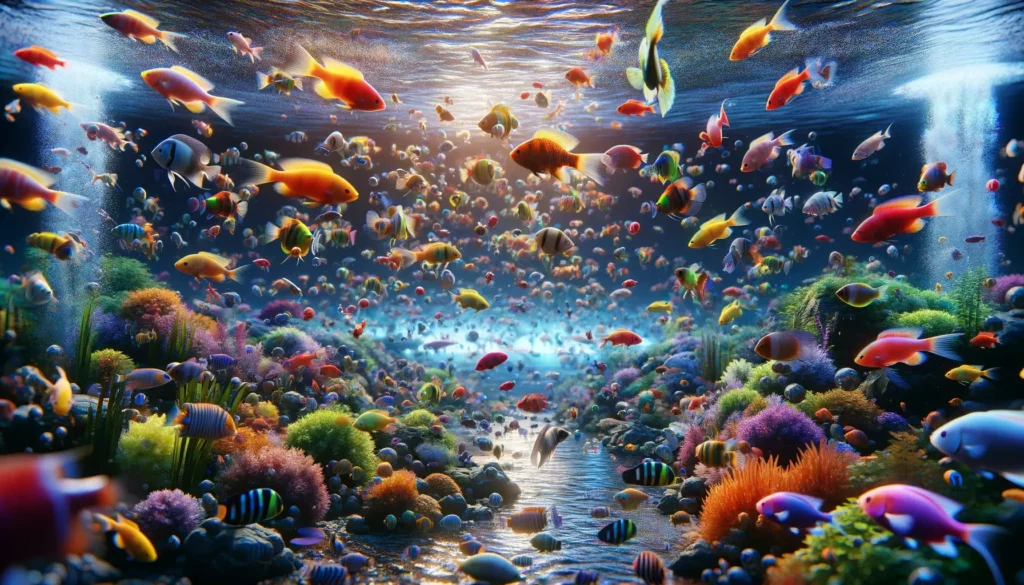
GloFish are celebrated for their mesmerizing colors, a result of genetic modification. Each species of GloFish exhibits unique color variants, influenced by specific genes. Here’s a comparative analysis of the color variants across different GloFish species:
- GloFish Zebra Danio: These fish were the first in the GloFish family, showcasing vibrant colors like red, green, blue, purple, and orange. The coloration in GloFish Zebra Danios is primarily due to the integration of a green fluorescent protein gene, originally from jellyfish, or a red fluorescent protein gene from corals.
- GloFish Tetra: GloFish Tetras exhibit a wide range of bright colors including pink, green, purple, and blue. The fluorescent coloration in Tetras is typically due to the incorporation of the same types of genes as in Zebra Danios, but the expression of the colors can appear differently due to the Tetra’s unique body type and scales.
- GloFish Barb: These fish are known for their intense and varied color palette, with options such as bold reds, bright greens, and deep purples. The advanced genetic modifications in GloFish Barbs involve more precise and varied integration of fluorescent genes, ensuring a brighter and more consistent glow.
- GloFish Shark: GloFish Sharks offer a different set of glowing hues, including electric green, radiant pink, and sunburst orange. The larger body size of the GloFish Shark allows for a more expansive display of their glowing colors. The specific genes used for GloFish Sharks are similar to those in other GloFish but are adapted to express vividly in the Shark’s distinct body type.
The specific genes responsible for the fluorescent colors in GloFish are carefully integrated into their DNA, ensuring that the colors are inherited naturally by offspring. These genes are sourced from naturally fluorescent marine organisms and are responsible for the production of fluorescent proteins. When exposed to specific types of light, these proteins absorb light and then re-emit it, creating the glowing effect that makes GloFish so captivating.
In conclusion, while all GloFish share the characteristic of glowing under certain types of light, each species has its own unique set of color variants and expressions. This diversity in coloration is a result of the specific integration and expression of fluorescent genes, making each GloFish species distinct in its own right. Whether you’re drawn to the active Zebra Danios, the fuller-bodied Tetras, the striking Barbs, or the commanding Sharks, each GloFish brings its own splash of color and personality to the aquarium.
Size and Shape
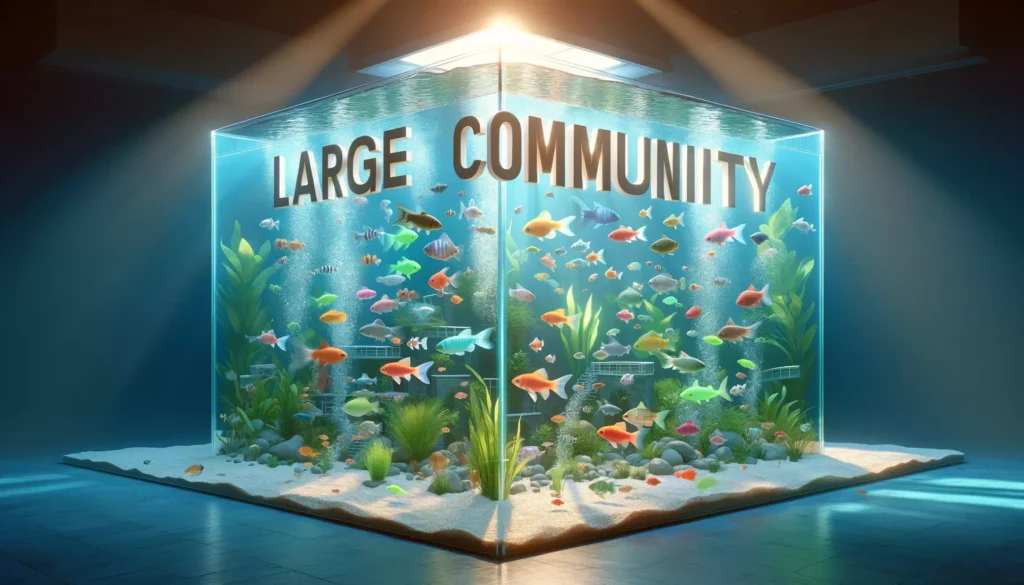
GloFish come in various sizes and body shapes, each adding its unique aesthetic to an aquarium. Here’s a comparative look at the size and body shape differences among GloFish species:
- GloFish Zebra Danio: These fish are relatively small and slender, reaching up to 2 inches in length. They have a streamlined body shape, which allows for swift and agile swimming. Their torpedo-shaped bodies are well-suited for darting around the tank and through plants.
- GloFish Tetra: GloFish Tetras grow to about 2.5 inches and have a fuller body compared to Zebra Danios. They have a more diamond-shaped body, which reflects light and color vividly, enhancing their glow. Their shape allows for a graceful, gliding movement in the water.
- GloFish Barb: GloFish Barbs can grow up to 3 inches in length. They have a more robust and rounded body compared to Zebra Danios and Tetras. The body shape of Barbs is more stout and muscular, indicative of their active and sometimes territorial nature.
- GloFish Shark: The largest in the GloFish family, GloFish Sharks can reach up to 4 inches. They have a distinct, elongated body with a prominent dorsal fin that resembles a shark, hence their name. Despite their size, they are peaceful fish, but their appearance adds a bold statement to the tank.
In terms of body shape differences:
- Zebra Danios have a slender, torpedo-like shape, suitable for quick movements.
- Tetras have a diamond-shaped, fuller body that beautifully displays their colors.
- Barbs are stout and robust, indicative of their more active and territorial behavior.
- Sharks have a distinct, elongated body with a shark-like dorsal fin, making them a unique and striking addition to any tank.
Understanding these size and shape differences is crucial for aquarists. It helps in choosing the right tank size and environment. For instance, larger, more active fish like GloFish Sharks may require more space and hiding spots. On the other hand, smaller, agile fish like Zebra Danios thrive in well-planted tanks that mimic their natural habitat. Recognizing these nuances ensures a healthy and harmonious tank, where each GloFish can exhibit its unique beauty and behavior.
Compatibility and Care
Creating a harmonious aquarium involves understanding the compatibility and specific care needs of each GloFish species. Here’s how different GloFish types can coexist and what care they require:
Compatibility in a Shared Aquarium
- GloFish Zebra Danio: Known for their peaceful nature, Zebra Danios are great for community tanks. They thrive in groups, so keeping them in schools of five or more is ideal. They are compatible with other peaceful GloFish like Tetras and Barbs but should be kept in a well-planted tank to provide hiding spaces and reduce stress.
- GloFish Tetra: GloFish Tetras are also peaceful and do well in community settings. They prefer to swim in schools and can coexist with Zebra Danios and Barbs. However, their fuller body shape might make them a target for nippy fish, so they should be paired with similarly peaceful species.
- GloFish Barb: Barbs can be a bit more territorial. They do best with other active and robust fish like GloFish Sharks. While they can coexist with Zebra Danios and Tetras, ensure the tank is spacious enough to accommodate their more assertive nature and provide plenty of hiding spots.
- GloFish Shark: Despite their size and “shark” name, they are generally peaceful. They should be kept in larger tanks due to their size and can coexist with other GloFish if there is enough space. Avoid keeping them with very small or timid fish.
| GloFish Species | Compatibility with Other GloFish | Recommended Tank Size | Additional Considerations |
|---|---|---|---|
| GloFish Zebra Danio | Peaceful; thrive in schools | Well-planted tank with hiding spaces | Compatible with Tetras and Barbs |
| GloFish Tetra | Peaceful; prefer schools | Suitable for community setups | Vulnerable to nippy fish; pair with peaceful species |
| GloFish Barb | Somewhat territorial | Spacious tank with hiding spots | Best with active and robust fish like GloFish Sharks |
| GloFish Shark | Generally peaceful | Requires larger tank | Avoid very small or timid fish |
Care Recommendations
- Tank Size and Conditions:
- Zebra Danios and Tetras thrive in a tank of at least 10 gallons, while Barbs and Sharks require more space, with a minimum of 20 gallons recommended.
- Maintain clean, well-filtered water with a stable temperature (around 72 to 82°F) and pH (around 6.5 to 7.5).
- Diet:
- All GloFish species benefit from a varied diet including high-quality flake food, frozen or live food like brine shrimp, and occasional plant-based treats. Ensure the food size is appropriate for the fish’s mouth.
- Social Interaction:
- Keep Zebra Danios, Tetras, and Barbs in groups (schools) to promote natural behavior and reduce stress.
- Provide GloFish Sharks with enough space to swim and establish territories to prevent aggression.
- Decor and Plants:
- Use plants, rocks, and decor to create hiding spots and reduce stress, especially for the more territorial Barbs and Sharks.
- Ensure the tank setup accommodates the swimming patterns of each species. For instance, Zebra Danios enjoy open swimming space at the top of the tank, while Tetras and Sharks prefer middle to bottom areas.
By understanding the unique needs and compatibility of each GloFish species, you can create a vibrant, healthy, and harmonious aquarium. This not only ensures the well-being of your GloFish but also allows their stunning colors and personalities to shine through.
Conclusion
In the captivating world of GloFish, each species brings its unique charm and color to the aquarium. From the agile Zebra Danios to the commanding GloFish Sharks, the diversity of these genetically modified fish allows aquarists to craft a vibrant underwater landscape that reflects their personal style and preferences.
Choosing the right GloFish species involves considering not just the visual appeal but also the compatibility and care requirements of each fish. Whether you prefer the swift movements of the Zebra Danios, the serene grace of the Tetras, the active demeanor of the Barbs, or the bold presence of the Sharks, understanding the specific needs and behaviors of your GloFish will ensure a harmonious and healthy aquarium.
The variety of GloFish species makes them not just fascinating pets but also colorful and lively additions to any aquarium. Their glowing colors, when paired with thoughtful care and a well-maintained environment, can transform your aquarium into a living work of art, showcasing the beautiful interplay of nature and scientific innovation.
So, whether you’re a seasoned aquarist or just starting in the hobby, consider the unique characteristics of each GloFish species. With the right mix of colors, sizes, and temperaments, your aquarium can become a mesmerizing aquatic haven, teeming with life and radiance. Let the diverse world of GloFish inspire you to create an underwater sanctuary that is not only a visual delight but also a testament to the wonders of aquatic life.
F.A.Q.
- Which GloFish species were originally created, and what changes were made to their genome?
The original GloFish species was the Zebra Danio, genetically modified to express fluorescent proteins. Scientists integrated genes from jellyfish and certain corals into their genome, enabling them to glow in various colors under specific lighting conditions. - What are the main characteristics that differentiate GloFish species, such as color and size?
GloFish species differ mainly in color, size, and body shape. Colors range from red, green, blue, purple, and orange, while sizes vary from the smaller Zebra Danios (up to 2 inches) to the larger GloFish Sharks (up to 4 inches). Body shapes also vary, from slender and streamlined to fuller and more robust. - What genetic technologies are used to create GloFish with different colors?
Genetic technologies involve inserting fluorescent protein genes from marine organisms like jellyfish and corals into the GloFish genome. This biotechnology ensures GloFish exhibit bright, fluorescent colors that are inherited by future generations. - Which GloFish species are most popular among aquarists and why?
Zebra Danios and Tetras are popular for their hardiness and easy care, making them suitable for beginners. GloFish Sharks are favored for their unique, shark-like appearance and vivid colors, appealing to enthusiasts looking for a standout species. - What environments and conditions are suitable for different GloFish species?
GloFish thrive in clean, well-filtered aquariums with stable temperatures (72 to 82°F) and pH levels (6.5 to 7.5). Tank size and decor should match each species’ size and activity level, with larger tanks for active or larger species like GloFish Sharks. - Can different GloFish species be kept in the same aquarium, and are there any special considerations for their cohabitation?
Different GloFish species can cohabitate if the tank is sufficiently spacious and well-structured with hiding spots. Peaceful species like Zebra Danios and Tetras can coexist, while more territorial species like Barbs and Sharks require careful observation and more space to prevent stress and aggression. - What care and maintenance do different GloFish species require?
GloFish require a balanced diet, clean water, and a proper tank environment. Regular feeding with high-quality fish food, routine water changes, and a tank setup that accommodates their swimming behavior and social interactions are essential. - Are there any restrictions or laws concerning the keeping of GloFish in different countries?
Yes, some countries and regions have restrictions or bans on genetically modified organisms, including GloFish. It’s crucial to check local regulations and guidelines before purchasing and keeping GloFish. - What trends in the development and creation of new GloFish species can be expected in the future?
Future trends may include the development of new GloFish species with enhanced colors, patterns, and even more resilient health traits. Advances in genetic modification might also lead to more environmentally adapted species. - What are the advantages and disadvantages associated with the popularity of GloFish among aquarists and society in general?
Advantages include increased interest in aquarium keeping, conservation awareness, and advancements in genetic research. However, concerns exist regarding genetic modification ethics, potential ecological impacts if released into the wild, and the necessity of responsible pet ownership and breeding practices.
